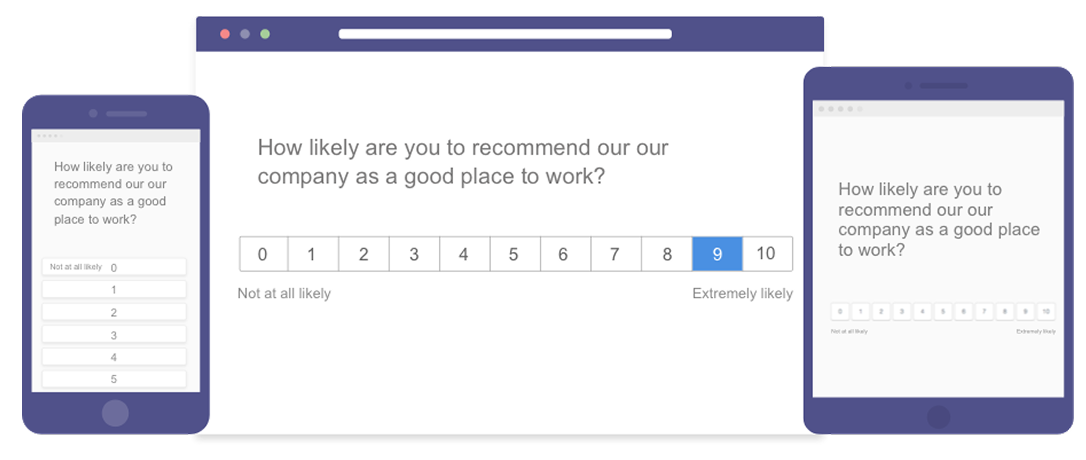Look at companies like Google and Apple. They’re not just admired for their innovative products—they excel at employee engagement. How? They track it relentlessly.
Gallup’s research shows that businesses with engaged employees outperform their competitors by 23% in profitability.
As competition for top talent heats up, understanding how to measure and improve engagement isn’t optional; it’s essential. Enter Employee Net Promoter Score (eNPS).
Knowing how to calculate eNPS gives you a snapshot of employee sentiment in a way that’s quick, actionable, and insightful. It’s not just about asking employees how they feel; it’s about capturing their emotional connection to your company and using those insights to improve culture and reduce turnover.
So, what exactly is eNPS, how do you calculate it, and how can it help your business thrive? You’ll find out everything in this blog.
What Is Employee Net Promoter Score (eNPS)?
Employee Net Promoter Score (eNPS) is a metric that helps you measure employee satisfaction and engagement.
If you’ve heard of Net Promoter Score (NPS) in the context of customer satisfaction, you’re already familiar with the general concept.
But eNPS is all about your employees. It asks one simple question –
“How likely are you to recommend this company as a good place to work to a friend or colleague?”

The result? You get a single, actionable score that tells you exactly where your team stands in terms of loyalty and overall satisfaction.
Want some more clarity on NPS? Watch this 2-minute video while sipping your glass of hot coffee:
Okay, now that we’re on the same page, let’s see how eNPS differs from customer NPS.
How eNPS Differs From Customer NPS
It’s simple. While the concepts behind both eNPS and NPS are the same, the audiences are different. Here’s a quick comparison –
| Survey Type | Focus | eNPS | Traditional Surveys |
|---|---|---|---|
| Purpose | Measure loyalty | Measures overall employee sentiment | Measures multiple facets of satisfaction |
| Question | “How likely are you to recommend?” | Focuses on loyalty & engagement | Focuses on different aspects of work |
| Frequency | Quick, frequent check-ins | Typically periodic (monthly, quarterly) | In-depth, annual, or bi-annual |
| Actionable Data | Simple, easy-to-understand metric | Provides clear insights into employee engagement | Detailed feedback on various areas |
Why Is eNPS Important for Your Business?
Engaged employees are more productive, more innovative, and more likely to stick around. And that’s exactly what eNPS helps you measure.
In fact, high eNPS scores are often correlated with better business performance.
Wondering what’s the connection? Let’s break this down.
- Employee Engagement: Employees who are invested in the company are far more likely to stay longer and be more productive.
- Retention: A low eNPS can signal higher turnover, which means you may be facing a disengaged workforce.
- Company Culture: eNPS serves as an indicator of whether your company culture is resonating with employees.
Incorporating eNPS into your HR strategy helps you understand where your company stands and where you can improve.
eNPS vs. Traditional Employee Satisfaction Surveys
Let me be very honest. Getting honest feedback from those lengthy employee satisfaction surveys can sometimes be very tough, especially if your workforce doesn’t applaud your work culture.
eNPS, on the other hand, is simple and quick.
The brevity encourages higher response rates, and the data is easier to interpret and act upon.

Plus, the direct link between eNPS and business outcomes makes it an essential metric for senior leadership to monitor.
That’s all the difference is. Here’s everything in a nutshell –
| Survey Type | Focus | eNPS | Traditional Surveys |
|---|---|---|---|
| Purpose | Measure loyalty | Measures overall employee sentiment | Measures multiple facets of satisfaction |
| Question | “How likely are you to recommend?” | Focuses on loyalty & engagement | Focuses on different aspects of work |
| Frequency | Quick, frequent check-ins | Typically periodic (monthly, quarterly) | In-depth, annual, or bi-annual |
| Actionable Data | Simple, easy-to-understand metric | Provides clear insights into employee engagement | Detailed feedback on various areas |
How To Calculate eNPS? (With Formula & Example)
Calculating your eNPS is straightforward and can be done using the following formula –
eNPS = % of Promoters – % of Detractors
Okay, now that you know the formula, here are some additional details for eNPS score calculation –
- Survey your employees with the eNPS question: “On a scale from 0-10, how likely are you to recommend this company as a place to work?”
- Categorize your respondents into Promoters, Passives, and Detractors based on their responses.
- Calculate the percentage of each group.
- Subtract the percentage of Detractors from Promoters.
Use Our Free eNPS Score Calculator
But what are these Promoters and Detractors? Let’s break it down.
- Promoters (score 9-10): These are your highly engaged employees who are likely to recommend your company as a great place to work.
- Passives (score 7-8): These employees are neutral, neither satisfied nor dissatisfied.
- Detractors (score 0-6): These are employees who are unhappy and unlikely to recommend your company.
Here’s a practical example for reference:
Imagine you surveyed 100 employees, and here’s how they scored –
- 60 employees are Promoters (score 9-10)
- 30 are Passives (score 7-8)
- 10 are Detractors (score 0-6)
Now, putting the formula into action –
eNPS = % of Promoters – % of Detractors
= { ( 60 / 100 ) x 100 } – { ( 10 / 100 ) x 100 }
= ( 60 – 10 )
= 50
Your eNPS score is 50, which signals a highly engaged workforce.
Fun fact: eNPS calculation is pretty much the same as calculating NPS. Just the audience is different.
Here’s a small, helpful video to help you understand the whole calculation above. And if you have already got the math, congrats! You just saved 136 seconds for a quick coffee break.
What Is a Good eNPS Score?
While eNPS varies by industry, a score of +50 is generally considered excellent.
However, what’s considered “good” can depend on the specifics of your company. For example, tech companies often see higher eNPS scores (60+), while other industries like healthcare may be around 40.
It’s also crucial to measure your eNPS against competitors in your field. If your score is lower than industry norms, that could indicate underlying issues with employee engagement or satisfaction.
Comparing your eNPS score to industry peers is essential for understanding whether you’re truly excelling or just meeting average standards.
FREE. All Features. FOREVER!
Try our Forever FREE account with all premium features!
How Often Should You Conduct an eNPS Survey?
Frequency matters when it comes to eNPS surveys. Conducting surveys too often can lead to survey fatigue, while not conducting them frequently enough might mean you’re missing important changes in employee sentiment.
Although there is no fixed schedule for these surveys, what’s also important to remember is that it largely depends on factors such as company size, employee turnover, and overall business goals.
For example, if turnover is high, more frequent surveys may be necessary to understand the reasons behind it.
Nevertheless, I’ll share some recommended frequency tips to follow before getting a hang of it yourself –
- Monthly: For high-growth companies or companies with rapid changes.
- Quarterly: Ideal for most companies as it provides enough time to analyze trends.
- Annually: Suitable for larger organizations with low turnover rates.
What To Do After Calculating eNPS? (Actionable Next Steps)
Let me guess… Your eNPS score was slightly lower than expected. Now, you’re wondering if all employees are going to submit their resignation letters tomorrow.
Well, it’s not really the end of the world. In fact, if you’re ready to take action, there’s still hope because it’s an opportunity to improve.
Here are some tried-and-tasted strategies to improve it –
- Engage with Detractors: Address their concerns and ask for specific feedback on what’s wrong.
- Implement Change: Act on the feedback and communicate those changes back to employees.
- Focus on Culture: Ensure your workplace culture is positive and inclusive.
Remember, closing the feedback loop is critical—employees need to see that their feedback leads to meaningful action.
Best Practices for Running an Effective eNPS Survey
Knowing how to calculate eNPS is one thing, but crafting an effective survey is another. You might think it’s about asking the right eNPS questions, but it’s more than that.
It’s about designing it to encourage honesty and clarity, about creating an environment where employees feel comfortable sharing their true feelings.
I’ll share some of the best practices I have learned over the years. Feel free to experiment if you have better ideas.
- Keep it simple: Avoid overwhelming employees with too many questions.
- Avoid bias: Ensure questions are neutral and do not lead employees to a particular answer.
- Leverage technology: Use employee survey tools to create seamless, easy-to-complete surveys that automatically calculate eNPS.
- Encourage honest feedback: Create a safe space for employees to share their thoughts without fear of retaliation.
- Avoid common mistakes: Don’t overcomplicate the survey, and be cautious about survey fatigue.
- Be honest: Make it clear that you’re committed to acting on feedback.
- Diversify your questions: Don’t just stick to the typical “How likely are you to recommend?” Spice it up with follow-up questions like “What’s one thing we can do to improve?”
Still looking for more information on creating these surveys? Stuck on creating surveys that get half-baked responses or questions that get skipped?
You can check out this dedicated blog on how to create NPS surveys that get responses.
Start Tracking Employee Sentiment Today With ProProfs Survey Maker
Employee sentiment is a powerful predictor of business success. Regularly measuring and acting on eNPS feedback can lead to a more engaged, satisfied workforce and, ultimately, better business performance.
If you’re not measuring it yet, now’s the time to start. But how?
Well, the first thing I’d do is try different employee survey tools like ProProfs Survey Maker. There, you can easily create and distribute eNPS surveys, track trends over time, and get real feedback that can help shape your company’s culture.
And the best part is that most of these software platforms let you try it first before making an investment. So, you can just sign up for now, start creating surveys, and if it feels right, you know what to do next, right?
Good luck!
FREE. All Features. FOREVER!
Try our Forever FREE account with all premium features!
Learn More About eNPS Surveys
Can eNPS be negative?
Yes, eNPS can be negative if there are more detractors than promoters. A negative score indicates low employee satisfaction and potential issues with retention or morale.
How do you benchmark eNPS against industry standards?
eNPS benchmarks vary by industry. For example, tech companies often have higher eNPS scores compared to sectors like manufacturing. You can compare your results with industry-specific reports or peer companies to get a sense of how your score measures up.
Should eNPS responses be anonymous?
Yes, eNPS responses should be anonymous. This ensures employees feel comfortable sharing honest feedback without fear of retaliation or bias, leading to more accurate results.
Can eNPS predict employee turnover?
A declining eNPS score can indicate potential turnover risks. If more employees become detractors, it signals dissatisfaction, which can lead to higher attrition rates if not addressed.
Does company size affect eNPS results?
Yes, company size can impact eNPS results. Smaller companies tend to have higher eNPS scores due to closer relationships and more direct communication, while larger organizations may face challenges like impersonal work environments and communication gaps.
How do you increase your eNPS score quickly?
To improve your eNPS score, act on employee feedback by addressing concerns about work culture, communication, and benefits. Make sure employees know their input is valued and that changes are being made based on their responses.
Can eNPS be used for remote teams?
Yes, eNPS is an effective tool for measuring engagement in remote teams. It helps identify issues specific to remote work, like communication challenges, and ensures that virtual employees feel connected and valued.
Can eNPS be manipulated by employees?
It’s possible for employees to manipulate their eNPS responses, especially if there’s a recent event that strongly influences their opinion. However, collecting data regularly helps smooth out these anomalies and provides a clearer picture.
How long should an eNPS survey be?
An eNPS survey should be short and to the point, ideally consisting of just the main question and 1-2 follow-up questions if needed. Keeping it brief encourages higher response rates and ensures employees can complete it quickly.
FREE. All Features. FOREVER!
Try our Forever FREE account with all premium features!
 We'd love your feedback!
We'd love your feedback!
 Thanks for your feedback!
Thanks for your feedback!






